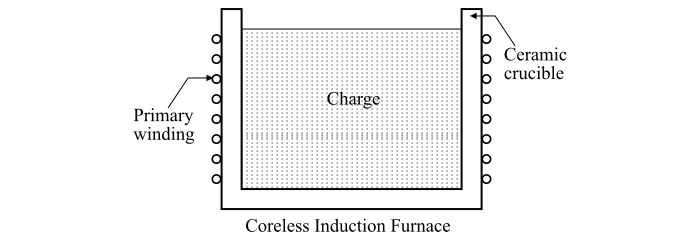
 Data Structure
Data Structure Networking
Networking RDBMS
RDBMS Operating System
Operating System Java
Java MS Excel
MS Excel iOS
iOS HTML
HTML CSS
CSS Android
Android Python
Python C Programming
C Programming C++
C++ C#
C# MongoDB
MongoDB MySQL
MySQL Javascript
Javascript PHP
PHP
- Selected Reading
- UPSC IAS Exams Notes
- Developer's Best Practices
- Questions and Answers
- Effective Resume Writing
- HR Interview Questions
- Computer Glossary
- Who is Who
Coreless Induction Furnace: Construction, Working, Advantages, Applications
Coreless Induction Furnace
Coreless induction furnace, also known as high frequency induction furnace, is a refractory lined vessel surrounded by an electrically energized, current carrying, water-cooled copper coil. As its name implies, no core is provided in the coreless induction furnace.
The electric current in the copper coil forms an electromagnetic field, generating heat energy that melts the charge.
Construction of Coreless Induction Furnace
The schematic diagram of a coreless type induction furnace is shown in the figure below.

It has the following three main parts viz −
Primary winding
Secondary winding − The ceramic crucible containing the charge forms the secondary winding.
Frame of the furnace − The frame of the furnace includes the supports and tilting mechanism.
The constructional features of the coreless type induction furnace are −
It contains no heavy iron core. Thus, there is no continuous path for magnetic flux.
The crucible and the coils are light weight and hence, the furnace can be conveniently tilted for pouring.
Working of Coreless Induction Furnace
The charge to be heated is put into the crucible and the primary winding is fed with a high frequency AC supply. The magnetic flux produced by the primary winding causes eddy currents to induce in the charge which tend to flow concentrically. These eddy currents heat up the charge to its melting point and also set up electromagnetic forces resulting into the stirring action which is essential for obtaining uniform quality of metal.
In the coreless induction furnace, due to absence of the magnetic core, the magnetic flux density is low. Therefore, high frequency AC supply has to be used because eddy current power loss is given by,
$$\mathrm{\mathit{P_{e}}\propto \mathit{B}^{\mathrm{2}}\mathit{f}^{\mathrm{2}}}$$
Where, B is the magnetic flux density and f is the supply frequency.
However, at this high frequency, the resistance of the primary winding is increased due to skin effect, thereby increasing the copper loss in the primary winding. For this reason, the primary winding is not made up of copper wire but consists of hollow copper tubes which are cooled by water circulating through them.
In case of coreless induction furnace, the magnetic coupling between the primary and secondary windings is very low, resulting in the very poor power factor (lies between 0.1 and 0.3) of the furnace. Therefore, Static capacitors are used in parallel with the furnace to improve the power factor. Also, the power factor of the furnace does not remain constant, but changes during the heat cycle, thus, capacitance in the circuit is to be varied to maintain approximately unity power factor.
Advantages of Coreless Induction Furnace
The main advantages of the coreless induction furnaces are given as follows −
The coreless induction furnaces are fast in operation.
They have low operating cost.
These can be operated intermittently.
Their charging and pouring is simple.
The melting time is very low.
There is precise control of power in case of coreless induction furnace.
The operation of the coreless induction furnace is free from smoke, dirt and noise.
Applications of Coreless Induction Furnace
Coreless induction furnaces are mainly used in the following applications −
Production of steel
Melting of non-ferrous metals such as bronze, brass, copper, etc.
For Vacuum melting
Melting for precision casting
Electronic industry
In brazing, soldering, hardening and annealing, etc.

